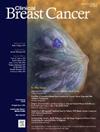整合放射组学和免疫相关基因特征预测乳腺癌腋窝淋巴结转移
IF 2.5
3区 医学
Q2 ONCOLOGY
引用次数: 0
摘要
背景:开发用于预测乳腺癌腋窝淋巴结(ALN)转移的放射基因组学提名图,并揭示放射基因组学特征与生物通路之间的内在联系:开发用于预测乳腺癌腋窝淋巴结(ALN)转移的放射基因组学提名图,并揭示放射基因组学特征与生物通路之间的潜在关联:本研究共纳入 1062 例乳腺癌患者,其中 90 例患者同时具有 DCE-MRI 和基因表达数据。首先计算了与ALN转移相关的最佳免疫相关基因和放射组学特征,并构建了相应的特征签名,以进一步验证其在预测ALN转移方面的性能。通过整合放射组学特征、免疫相关基因(IRG)特征和关键临床病理因素,建立了预测ALN转移风险的放射组学提名图。通过加权基因共表达网络分析(WGCNA)确定了与关键放射组学特征相关的基因模块,并进行了功能富集分析。基因组变异分析(GSVA)和相关性分析用于研究放射组学特征与生物通路之间的关联:结果:放射基因组学提名图在预测ALN转移方面显示出良好的预测能力,训练组和测试组的AUC分别为0.973和0.928。WGCNA和功能富集分析表明,与关键放射组学特征相关的基因模块主要富集在乳腺癌转移相关通路中,如局灶粘附、ECM-受体相互作用和细胞粘附分子。GSVA 还发现了与糖原合成、能量代谢整合等放射组学特征相关的通路活动:放射基因组学提名图可作为预测 ALN 转移风险的有效工具。这项研究进一步证明,放射组学表型可能是由与乳腺癌转移相关的生物通路驱动的。本文章由计算机程序翻译,如有差异,请以英文原文为准。
Integration of Radiomics and Immune-Related Genes Signatures for Predicting Axillary Lymph Node Metastasis in Breast Cancer
Background
To develop a radiogenomics nomogram for predicting axillary lymph node (ALN) metastasis in breast cancer and reveal underlying associations between radiomics features and biological pathways.
Materials and methods
This study included 1062 breast cancer patients, 90 patients with both DCE-MRI and gene expression data. The optimal immune-related genes and radiomics features associated with ALN metastasis were firstly calculated, and corresponding feature signatures were constructed to further validate their performances in predicting ALN metastasis. The radiogenomics nomogram for predicting the risk of ALN metastasis was established by integrating radiomics signature, immune-related genes (IRG) signature, and critical clinicopathological factors. Gene modules associated with key radiomics features were identified by weighted gene co-expression network analysis (WGCNA) and submitted to functional enrichment analysis. Gene set variation analysis (GSVA) and correlation analysis were performed to investigate the associations between radiomics features and biological pathways.
Results
The radiogenomics nomogram showed promising predictive power for predicting ALN metastasis, with AUCs of 0.973 and 0.928 in the training and testing groups, respectively. WGCNA and functional enrichment analysis revealed that gene modules associated with key radiomics features were mainly enriched in breast cancer metastasis-related pathways, such as focal adhesion, ECM-receptor interaction, and cell adhesion molecules. GSVA also identified pathway activities associated with radiomics features such as glycogen synthesis, integration of energy metabolism.
Conclusion
The radiogenomics nomogram can serve as an effective tool to predict the risk of ALN metastasis. This study provides further evidence that radiomics phenotypes may be driven by biological pathways related to breast cancer metastasis.
求助全文
通过发布文献求助,成功后即可免费获取论文全文。
去求助
来源期刊

Clinical breast cancer
医学-肿瘤学
CiteScore
5.40
自引率
3.20%
发文量
174
审稿时长
48 days
期刊介绍:
Clinical Breast Cancer is a peer-reviewed bimonthly journal that publishes original articles describing various aspects of clinical and translational research of breast cancer. Clinical Breast Cancer is devoted to articles on detection, diagnosis, prevention, and treatment of breast cancer. The main emphasis is on recent scientific developments in all areas related to breast cancer. Specific areas of interest include clinical research reports from various therapeutic modalities, cancer genetics, drug sensitivity and resistance, novel imaging, tumor genomics, biomarkers, and chemoprevention strategies.
 求助内容:
求助内容: 应助结果提醒方式:
应助结果提醒方式:


